Gut Health in Poultry - The World Within
Published: May 12, 2015
By: Richard Bailey, Poultry Health Scientist (Aviagen)
Introduction
The efficient conversion of feed into its basic components for optimal nutrient absorption is vital for both broiler and broiler breeder production and welfare. Gut health, an intricate and complex area combining nutrition, microbiology, immunology and physiology, has a key role to play. When gut health is compromised, digestion and nutrient absorption are affected which, in turn, can have a detrimental affect on feed conversion leading to economic loss and a greater susceptibility to disease. In addition, recent changes in legislation on the use of antimicrobials, differing feed requirements and more efficient birds highlight the need for a better understanding of gut function and gut health. This article aims to explore the area of gut health and outline key factors that are important in the development and maintenance of optimal gut function.
An Overview of the Gut and How it Works
The intestinal tract of a bird is a specialized tube that starts at the beak and ends in the cloaca. The primary function of the gut is the conversion and digestion of food into its basic components for absorption and utilization by the bird. The gut is separated into 5 distinct regions (Figure 1); the crop, proventriculus, gizzard, small intestine (duodenum, jejunum, and ileum), and large intestine (caeca, colon and rectum). Each of these regions has a specific role in the digestion process and absorption of nutrients.
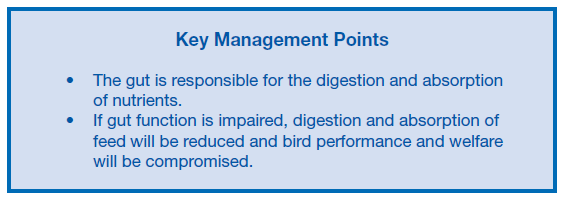
Figure 1: The gastrointestinal tract of a chicken.
Figure 2: Electron micrograph of villi (left) and microvilli (right) of the small intestine.

Gut Inhabitants – A World to Discover
The community of microorganisms in the gut is referred to in many ways: friendly bacteria, gut flora, gut microbiota. It is a diverse community of mainly bacteria, fungi, protozoa, and viruses. It has been estimated that the bacterial cells outnumber the host (bird) cells by approximately ten to one and while modern DNA-based technologies have given a much more accurate picture of the bacterial species present in the gut it has become increasingly evident that a large number of bacteria in the gut are currently unknown and unclassified. Recent studies focusing on poultry have proposed that the gastrointestinal (GI) tract of a broiler chicken is colonized by an estimated 640 species of bacteria. The abundance and diversity of the microbiota varies along the GI tract and, predictably, the regions which have less tolerable conditions and faster passage of gut contents have lower numbers of bacteria. It is generally considered that the development of the adult gut microbiota begins on hatching where bacteria are picked up from the environment, the feed, and the people handling the chicks post-hatch. The crop is rapidly colonized within 24 hours. After one day post-hatch the ileum and caeca are also both dominated by bacteria. After three days the level of bacteria in the small and large intestine increases 10 fold. Within two weeks, the typical adult small intestinal microbiota will be well established and after 30 days the caecal flora will have also developed. The time taken for the establishment of the stable adult microbiota can be reduced with optimal brooding conditions and good feed quality.
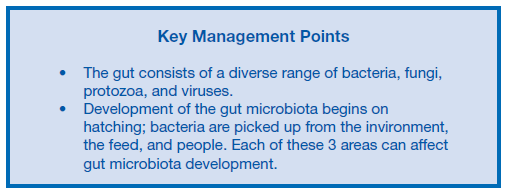
The crop harbors a large population of lactobacilli. These bacteria ferment the feed and produce lactic acid which reduces the pH of the crop environment. The conditions within the proventriculus are highly acidic creating an environment which is unsuitable for most bacteria. The gizzard also has an acidic environment but has a substantial population of lactobacilli which originates mainly from the crop. The bacterial population of the small intestine is made up of mainly lactobacilli although enterococci, E. coli, eubacteria, clostridia, propionibacteria, and fusobacteria can sometimes be found. The bacterial population of the small intestine evolves as the bird ages but will generally be stable by two weeks of age. The caeca provides a more stable environment which allows the colonization of slower growing bacteria. Early on the caeca are dominated by lactobacilli, coliforms, and enterococci, but by three to four weeks of age the adult caecal flora should be well established and consists of bacteroides, eubacteria, bifidobacteria, lactobacilli, and clostridia.
Role of the Intestinal Microbiota
Within the GI tract there are multiple interactions between the host (bird) cells, the intestinal environment, bacterial cells, and feed components. These interactions emphasize the extremely important role of gut microbiota in the health and well being of the host (as discussed below) although the exact way in which this is achieved is not yet fully understood.
The bacterial community of the intestinal microbiota form a protective barrier which lines the gut preventing the growth of pathogenic bacteria such as Salmonella, Campylobacter, and Clostridium perfringens. This principle is most commonly known as competitive exclusion. Theories suggest that the commensal (or friendly) microbiota dominate attachment sites on the gut cells reducing the opportunity for attachment and colonization by pathogens. Another proposed mechanism is that the intestinal microbiota are able to secrete compounds, including volatile fatty acids, organic acids, and natural antimicrobial compounds (know as bacteriocins), that either inhibit the growth of or make the environment unsuitable for less favorable bacteria.
Studies using germ-free animals have also shown that the intestinal microbiota is important in the stimulation and development of the immune system. It is thought that the commensal microbiota maintain the gut immune system in a state of ‘alert’ so that it can react quickly to pathogens. The gut microbiota is also considered to be an important factor in the development and maturation of the immune system. Studies have shown that animals lacking a gut microbiota are more susceptible to disease and have poorly developed immune tissues. In addition to protection against disease and stimulation of the immune system, the intestinal microbiota can influence host growth rates by producing extra nutrients through the fermentation of the indigestible plant fibers that the birds can’t digest.
The Balance of Gut Health
Gut health relies on the maintenance of the delicate balance between the host, the intestinal microbiota, the intestinal environment, and dietary compounds. This balance can be significantly affected by bird management and environment. If there is an imbalance in this relationship then gut health can be compromised. When gut health is optimal the efficient digestion and absorption of the nutrient components of feed will occur. Dietary fats, sugars, and protein components are absorbed from the small intestine and the remaining indigestible dietary components (e.g. plant fibers, cellulose) pass into the caeca where fermentative bacteria convert these fibers into extra energy for the host. This can be due to increased secretion of mucus, villi damage or secretion of immune cells into the gut. Malabsorption of nutrients results in more nutrients being available to the small intestinal bacteria which can result in an overgrowth of the bacterial population. Furthermore malabsorption can result in proteins, sugars, and fat passing into the caeca causing a shift in the microbial population away from the preferred fermentative bacteria. The balance of the microbiota in the gut can be affected by factors such as:
- Periods of high challenge (e.g. feed change-overs and vaccination).
- Feed (quality and raw materials).
- Biosecurity.
- Environment (temperature and ventilation).
- Brooding conditions.
- Infections with viruses, bacteria, or coccidiosis or the presence of mycotoxins.
Diet has been found to be the most influential factor on the composition of the gut microbiota and Figure 3 highlights how diet can change the gut flora.
Figure 3: Principle Component Analysis of bacterial communities in the caeca of broilers fed on a high protein diet (+) (120% of standard diet) and low protein diet (?) (80% of standard diet). Each point on the chart represents one bird fed one of the diets. The closer the points on the chart are the more similar the bacterial population in the caeca. We can see that there is a separation of the red points away from the blue points (as shown by the dotted line) indicating that the bacterial populations are different in the caeca between the birds fed on the different diets.

Changes in the bacterial populations of the small intestine and caeca that occur during an imbalance is commonly referred to as dysbacteriosis and if prolonged can have negative effects on the host (see box below). The shift in caecal bacterial activity results in the production of different bacterial metabolites (the compounds produced by bacteria when they break down nutrients). Some of these metabolites, such as amines produced from bacteria metabolism of amino acids, can cause gut irritation making the ongoing gut upset worse.
The presence of certain bacteria is increased during dysbacteriosis, the action of these bacteria further affects nutrient absorption. For example, some bacteria can reduce fat absorption by inactivating the bile acids which capture fats out of the diet. Other bacteria can destroy the surface of the villi reducing the surface area available for nutrient absorption. When nutrient absorption is reduced it is not uncommon for birds to increase their feed intake in an attempt to meet their nutritional demands. This results in faster gut transit time, feed passage, and wetter litter.

If the gut is properly developed and the immune system is not compromised the impact of a gut upset on bird growth (and FCR) can be reduced. After the birds hatch and get access to feed and water the gut is triggered into its final stages of maturation. Optimal gut development relies on optimal bird management, particularly during periods of high challenge such as vaccination or during feed change-overs, and good early access to feed and water. In addition, in the field it has been observed that the chicks receiving good brooding tend to develop a gut that performs well and has a greater capacity to cope with challenges in the broiler shed. Brooding management is key for establishing a healthy gut. During the first week of life the gut undergoes rapid maturation such that elongation of the villi reaches 50% of adult villus size. If chicks do not receive appropriate brooding management or feed intake is not increasing normally, gut development will be impaired resulting in a poorly functioning gut. If this poorly functioning gut is then exposed to a further stress the impact on bird growth, health, and welfare can be significant. Coccidiosis infection provides a good example of the effect that poor villi development can have. During a coccidiosis infection with Eimeria maxima the villi become shortened and the villi tips are eroded – reducing gut surface area. If villi have developed properly the impact of coccidiosis will be less due to the greater reserve capacity of the villi being longer from the outset (Figure 4).
Figure 4: Effect of coccidiosis infection on villi development in normal and poorly developed villi.

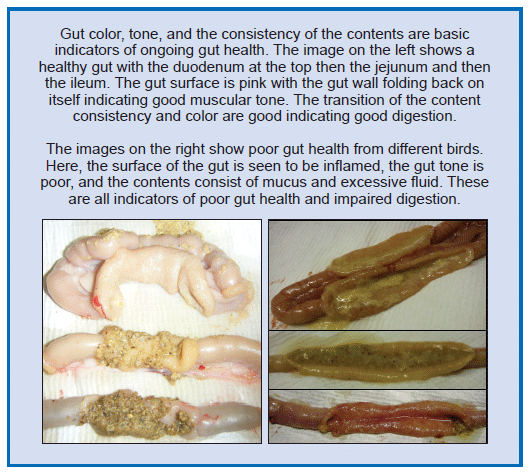
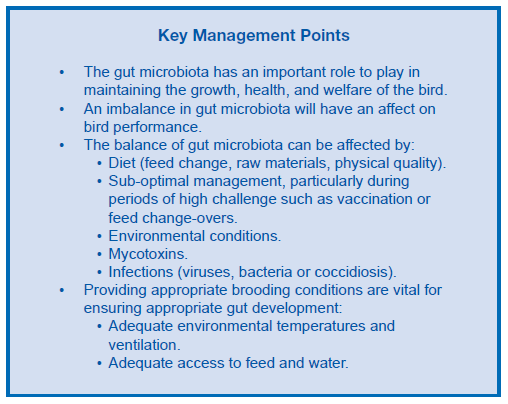
Gut Health Research
Gut health provides for an active area of research in both human and animal science. Aviagen® is committed to gaining a better understanding of gut flora, gut function, and gut immunity by undertaking internal research projects and collaborating with universities to ensure the latest technologies and knowledge are exploited to improve bird gut health in the field.
Conclusions
Maintaining the balance of good gut health is a key aspect of getting the best growth and FCR out of any food producing animal. Many researchers have attempted to understand gut flora, gut function, and gut immunity. It is increasingly evident that the gut remains a highly complex area. Regional variations in poultry production, management styles, climate, disease challenge, and feed raw materials add further complexity to maintaining good gut health but what is clear is that developing and maintaining gut health through good bird management practices is key to maintaining bird health, welfare, and performance.
Factors to consider when it comes to gut health
Aviagen Brief - Gut Health in Poultry, August 2013
Related topics:
Recommend
Comment
Share
22 de julio de 2015
My experience tells me that before the arrival of day old chicks vitaminated water and glucose should be served first for about an hour before serving chick mash. This would allow the chicks to rest well before feeding. This would also ensure uniform growth in the flock as feeding resumes nearly at the same time within the flock.
Recommend
Reply
16 de junio de 2015
Many thanks for this educative article/ publication. Please, i wish to ask that what would be the influence on gut health if antibiotics are introduce while using probiotics on both layers and broilers in the face of an infection ?
Recommend
Reply
Jubilant Life Sciences Ltd.
15 de junio de 2015
Nice very important and informative article .
Thanks for sharing knowledge.
Recommend
Reply
4 de junio de 2015
It is an excellent article, every poultry farmer should go through to learn the gut health management which is the most important for profitable poultry business...
Recommend
Reply
Recommend
Reply
18 de octubre de 2015
Gut health can be maintained by introducing probiotics/organic acids on very first days, until the production of natural probiotics on next week.
Recommend
Reply
Recommend
Reply
19 de julio de 2015
Please help out. I want collect baby chick and I want to surve water and feed before chick arrive, it's good
Recommend
Reply
Recommend
Reply
12 de junio de 2015
Thanks, so much. I hav question, how many percent that microbiota can improve performance, especially for weight gain?
Recommend
Reply

Would you like to discuss another topic? Create a new post to engage with experts in the community.

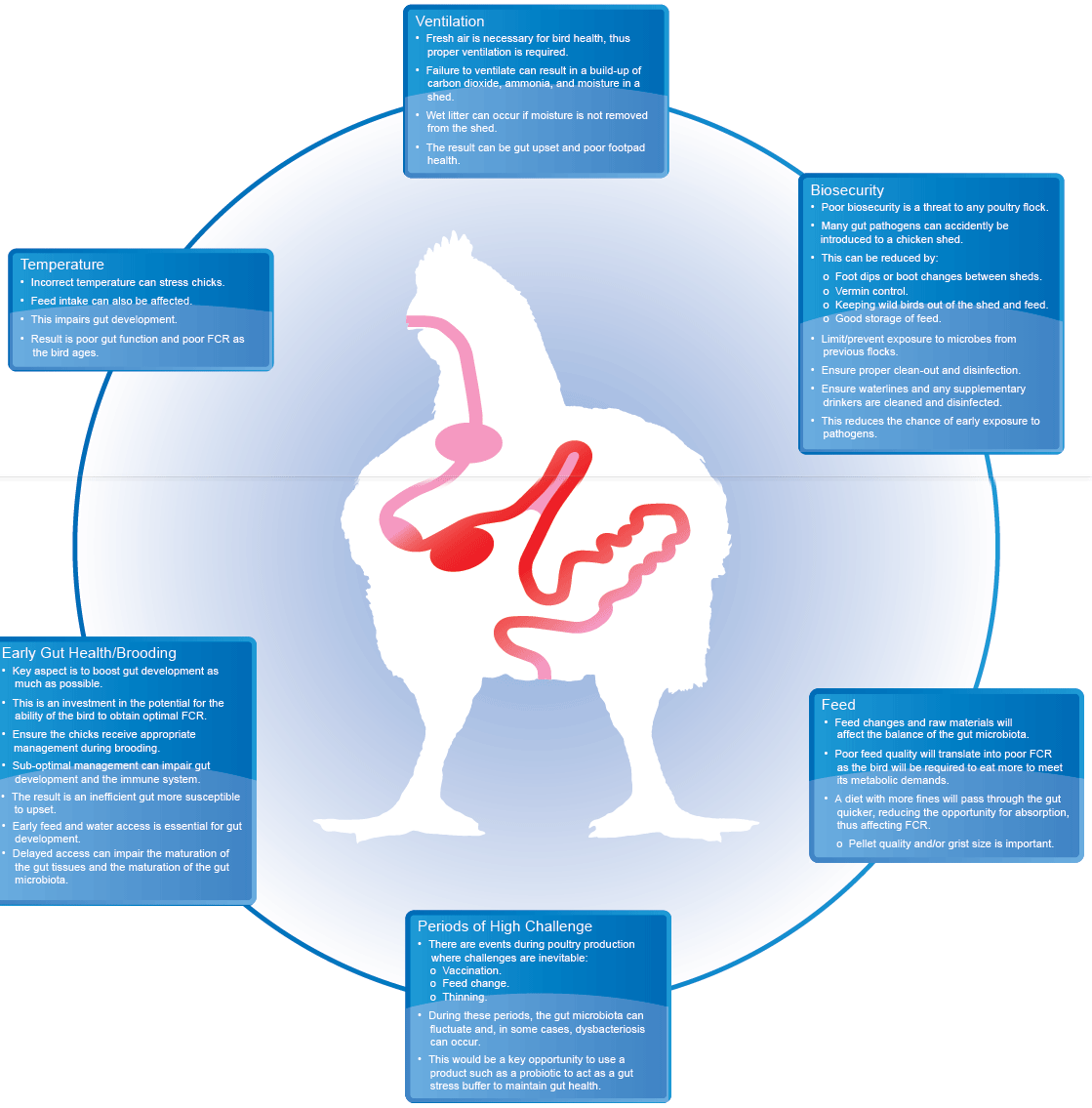














.jpg&w=3840&q=75)